Structural Design and Control Research of Multi-Segmented Biomimetic Millipede Robot
Abstract
:1. Introduction
2. Biological Research
3. Structural Design and Mathematical Modeling
3.1. Single-Unit System
3.2. Kinematics
3.3. Inverse Kinematics
4. Improved CPG Control Algorithm
4.1. CPG Oscillation Unit Model
4.2. CPG Control Network
4.2.1. Interfoot Coordination Control
4.2.2. Intrafoot Coordination Control
5. Robot Physical Prototypes and Experiments
5.1. Robot Hardware Composition
5.2. Robot Software Section
5.3. Experimental
5.3.1. Standard Traveling Wave Gait Walking
5.3.2. Walk with Broken Legs
5.3.3. Walking on Complex Surfaces
6. Conclusions
- In studies of millipede’s wave gait, single-leg reference circle or ellipse models are commonly used, but ensuring stability of posture is challenging. This paper proposes a general model with three degrees of freedom based on the analysis of millipede physiology and locomotion mechanisms. By implementing forward and inverse kinematics of the leg structure, which consists of three linked rods in series, the effective and controllable variation of leg length is achieved, ensuring smooth motion of the entire robot while also accommodating a planar model at the foot end.
- The three-degree-of-freedom walking mechanism combined with the matching CPG algorithm offers higher computational efficiency and simpler model construction compared to traditional control methods based on static stability and dynamic model-based control.
- Modeled after the actual neural structure, the oscillatory coupling framework reduces the number of oscillators by 75%. During locomotion, the fluctuation of longitudinal acceleration is less than 0.2 m/s2, and the fluctuation of lateral acceleration is less than 0.3 m/s2, ensuring the stability of the walking gait.
- The ecological analysis of the millipede and its corresponding locomotion system can be applied not only to conventional hard surfaces; they can also be further optimized to adapt to harsh environments such as farmland slopes, tidal flats, deserts, and barren wastelands. By incorporating various attachments, the millipede robot can achieve functions including load-bearing, operation, rescue, and detection.
Author Contributions
Funding
Institutional Review Board Statement
Informed Consent Statement
Data Availability Statement
Acknowledgments
Conflicts of Interest
References
- Fan, J.; Du, Q.; Dong, Z.; Zhao, J.; Xu, T. Design of the Jump Mechanism for a Biomimetic Robotic Frog. Biomimetics 2022, 7, 142. [Google Scholar] [CrossRef] [PubMed]
- Chen, G.; Qiao, L.; Zhou, Z.; Richter, L.; Ji, A. Development of a Lizard-Inspired Robot for Mars Surface Exploration. Biomimetics 2023, 8, 44. [Google Scholar] [CrossRef] [PubMed]
- Pei, X.; Liu, S.; Wei, A.; Shi, R.; Dai, Z. Bioinspired Rigid–Flexible Coupled Adaptive Compliant Motion Control of Robot Gecko for Space Stations. Biomimetics 2023, 8, 415. [Google Scholar] [CrossRef]
- Goldfarb, M.; Gogola, M.; Fischer, G.; Garcia, E. Development of a piezoelectrically-actuated mesoscale robot quadruped. J. Micromechatron. 2001, 1, 205–219. [Google Scholar] [CrossRef]
- Birkmeyer, P.; Peterson, K.; Fearing, R.S. DASH: A dynamic 16g hexapedal robot. In Proceedings of the 2009 IEEE/RSJ International Conference on Intelligent Robots and Systems, St. Louis, MO, USA, 10–15 October 2009; pp. 2683–2689. [Google Scholar]
- Ho, T.; Choi, S.; Lee, S. Development of a biomimetic quadruped robot. J. Bionic Eng. 2007, 4, 193–199. [Google Scholar] [CrossRef]
- Ni, Y.; Li, L.; Qiu, J.; Sun, Y.; Qin, G.; Han, Q.; Ji, A. A Novel Wheel-Legged Hexapod Robot. Biomimetics 2022, 7, 146. [Google Scholar] [CrossRef]
- Zarrouk, D.; Mann, M.; Degani, N.; Yehuda, T.; Jarbi, N.; Hess, A. Single actuator wave-like robot (SAW): Design, modeling, and experiments. Bioinspir. Biomim. 2016, 11, 046004. [Google Scholar] [CrossRef]
- Mingchinda, N.; Jaiton, V.; Leung, B.; Manoonpong, P. Leg-body coordination strategies for obstacle avoidance and narrow space navigation of multi-segmented, legged robots. Front. Neurorobot. 2023, 17, 1214248. [Google Scholar] [CrossRef]
- Garcia, A.; Priya, S.; Marek, P. Understanding the locomotion and dynamic controls for millipedes: Part 1—Kinematic analysis of millipede movements. In Proceedings of the Smart Materials, Adaptive Structures and Intelligent Systems, Colorado Springs, CO, USA, 21–23 September 2015; p. V002T006A005. [Google Scholar]
- Manton, S. The evolution of arthropodan locomotory mechanisms—Part 3. the locomotion of the chilopoda and pauropoda. Zool. J. Linn. Soc. 1952, 42, 118–167. [Google Scholar] [CrossRef]
- Homchanthanakul, J.; Manoonpong, P. Proactive body joint adaptation for energy-efficient locomotion of bio-inspired multi-segmented robots. IEEE Robot. Autom. Lett. 2023, 8, 904–911. [Google Scholar] [CrossRef]
- Wan, X.; Song, S.-M. A cam-controlled, single actuator-driven leg mechanism for legged vehicles. In Proceedings of the ASME International Mechanical Engineering Congress and Exposition, Anaheim, CA, USA, 13–19 November 2004; pp. 1287–1292. [Google Scholar]
- Garcia, A.; Krummel, G.; Priya, S. Fundamental understanding of millipede morphology and locomotion dynamics. Bioinspir. Biomim. 2020, 16, 026003. [Google Scholar] [CrossRef] [PubMed]
- Kano, T.; Sakai, K.; Yasui, K.; Owaki, D.; Ishiguro, A. Decentralized control mechanism underlying interlimb coordination of millipedes. Bioinspir. Biomim. 2017, 12, 036007. [Google Scholar] [CrossRef] [PubMed]
- Koh, D.; Yang, J.; Kim, S. Millipede robot for uneven terrain exploration: Design and experiment of the flexible biomimetic robot mechanism. In Proceedings of the 2010 3rd IEEE RAS & EMBS International Conference on Biomedical Robotics and Biomechatronics, Tokyo, Japan, 26–29 September 2010; pp. 877–881. [Google Scholar]
- Ozkan-Aydin, Y.; Chong, B.; Aydin, E.; Goldman, D.I. A systematic approach to creating terrain-capable hybrid soft/hard myriapod robots. In Proceedings of the 2020 3rd IEEE International Conference on Soft Robotics (RoboSoft), New Haven, CT, USA, 15 May–15 July 2020; pp. 156–163. [Google Scholar]
- Hoffman, K.L. Design and Locomotion Studies of a Miniature Millipede-Inspired Robot. Doctoral Dissertation, Harvard University, Cambridge, MA, USA, 2013. [Google Scholar]
- Avirovik, D.; Butenhoff, B.; Priya, S. Millipede-inspired locomotion through novel U-shaped piezoelectric motors. Smart Mater. Struct. 2014, 23, 037001. [Google Scholar] [CrossRef]
- Avirovik, D.; Priya, S. Crawling-inspired robot utilizing L-shape piezoelectric actuators. In Proceedings of the 2013 IEEE/ASME International Conference on Advanced Intelligent Mechatronics, Wollongong, NSW, Australia, 9–12 July 2013; pp. 894–899. [Google Scholar]
- Brown, T.G. The intrinsic factors in the act of progression in the mammal. Proc. R. Soc. Lond. B 1911, 84, 308–319. [Google Scholar] [CrossRef]
- Matsuoka, K. Mechanisms of frequency and pattern control in the neural rhythm generators. Biol. Cybern. 1987, 56, 345–353. [Google Scholar] [CrossRef]
- Kimura, H.; Fukuoka, Y.; Cohen, A.H. Adaptive Dynamic Walking of a Quadruped Robot on Natural Ground Based on Biological Concepts. Int. J. Robot. Res. 2007, 26, 475–490. [Google Scholar] [CrossRef]
- Righetti, L.; Ijspeert, A.J. Design methodologies for central pattern generators: An application to crawling humanoids. In Proceedings of the Robotics: Science and Systems, Philadelphia, PA, USA, 16–19 August 2006; pp. 191–198. [Google Scholar]
- Ijspeert, A.J.; Crespi, A.; Ryczko, D.; Cabelguen, J.-M. From swimming to walking with a salamander robot driven by a spinal cord model. Science 2007, 315, 1416–1420. [Google Scholar] [CrossRef] [PubMed]
- Grabowska, M.; Toth, T.I.; Smarandache-Wellmann, C.; Daun-Gruhn, S. A network model comprising 4 segmental, interconnected ganglia, and its application to simulate multi-legged locomotion in crustaceans. J. Comput. Neurosci. 2015, 38, 601–616. [Google Scholar] [CrossRef]
- Song, Z.; Zhu, J.; Xu, J. Gaits generation of quadruped locomotion for the CPG controller by the delay-coupled VDP oscillators. Nonlinear Dyn. 2023, 111, 18461–18479. [Google Scholar] [CrossRef]
- Chen, L.; Cai, Y.; Bi, S. Central Pattern Generator (CPG)-Based Locomotion Control and Hydrodynamic Experiments of Synergistical Interaction between Pectoral Fins and Caudal Fin for Boxfish-like Robot. Biomimetics 2023, 8, 380. [Google Scholar] [CrossRef]
- Asif, U. Virtual Reality to Simulate Adaptive Walking in Unstructured Terrains for Multi-Legged Robots. Virtual Real. Hum. Comput. Interact. 2012. [Google Scholar] [CrossRef]
- Yu, J.; Tan, M.; Chen, J.; Zhang, J. A survey on CPG-inspired control models and system implementation. IEEE Trans. Neural Netw. Learn. Syst. 2013, 25, 441–456. [Google Scholar] [CrossRef] [PubMed]
- Wang, Z.; Gao, Q.; Zhao, H. CPG-inspired locomotion control for a snake robot basing on nonlinear oscillators. J. Intell. Robot. Syst. 2017, 85, 209–227. [Google Scholar] [CrossRef]
- Nor, N.M.; Ma, S. A simplified CPGs network with phase oscillator model for locomotion control of a snake-like robot. J. Intell. Robot. Syst. 2014, 75, 71–86. [Google Scholar] [CrossRef]
- Righetti, L.; Ijspeert, A.J. Pattern generators with sensory feedback for the control of quadruped locomotion. In Proceedings of the 2008 IEEE International Conference on Robotics and Automation, Pasadena, CA, USA, 19–23 May 2008; pp. 819–824. [Google Scholar]
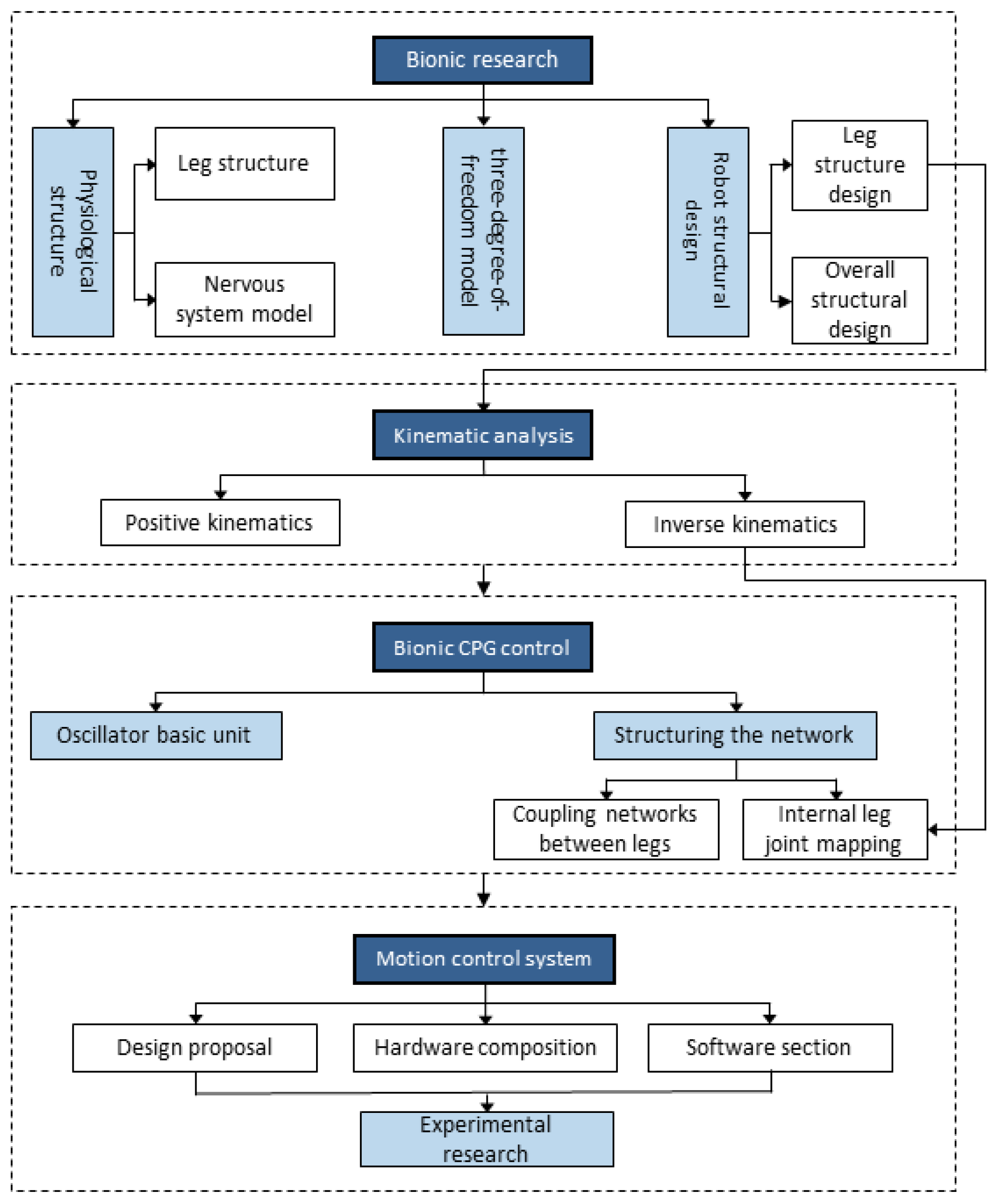

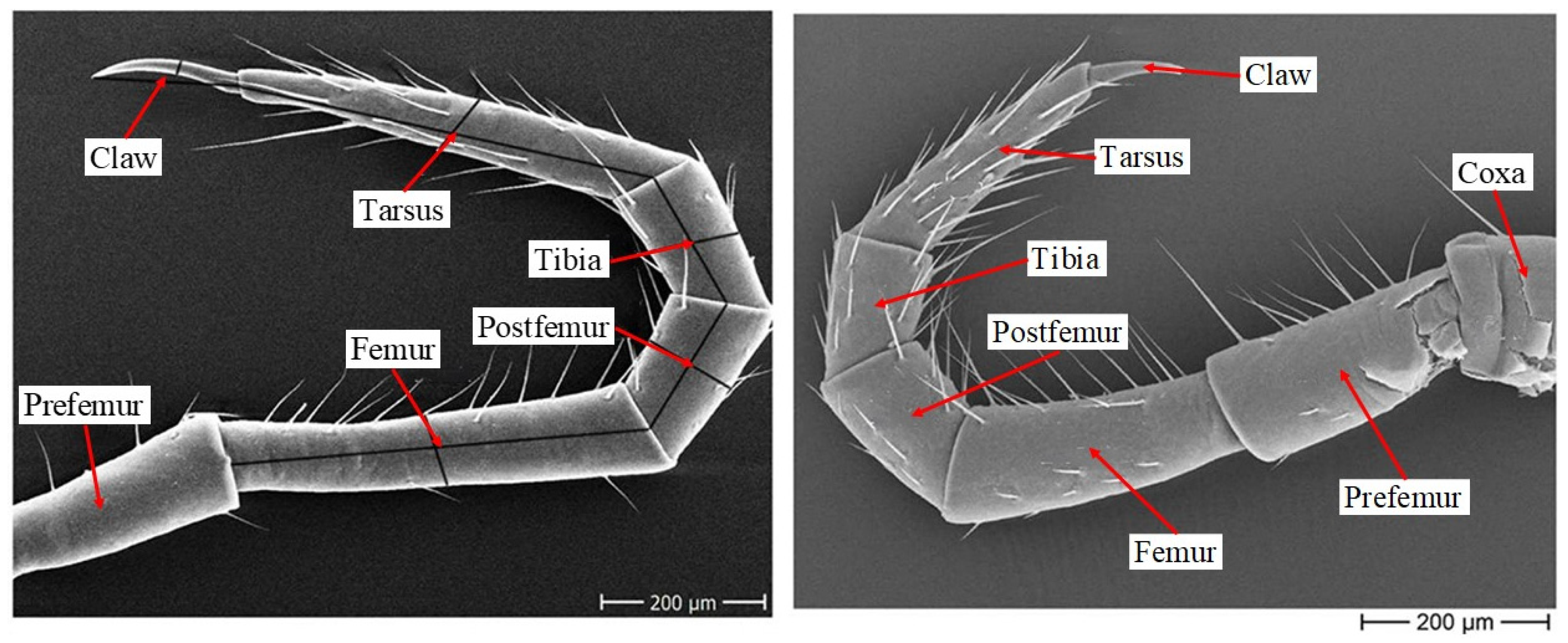
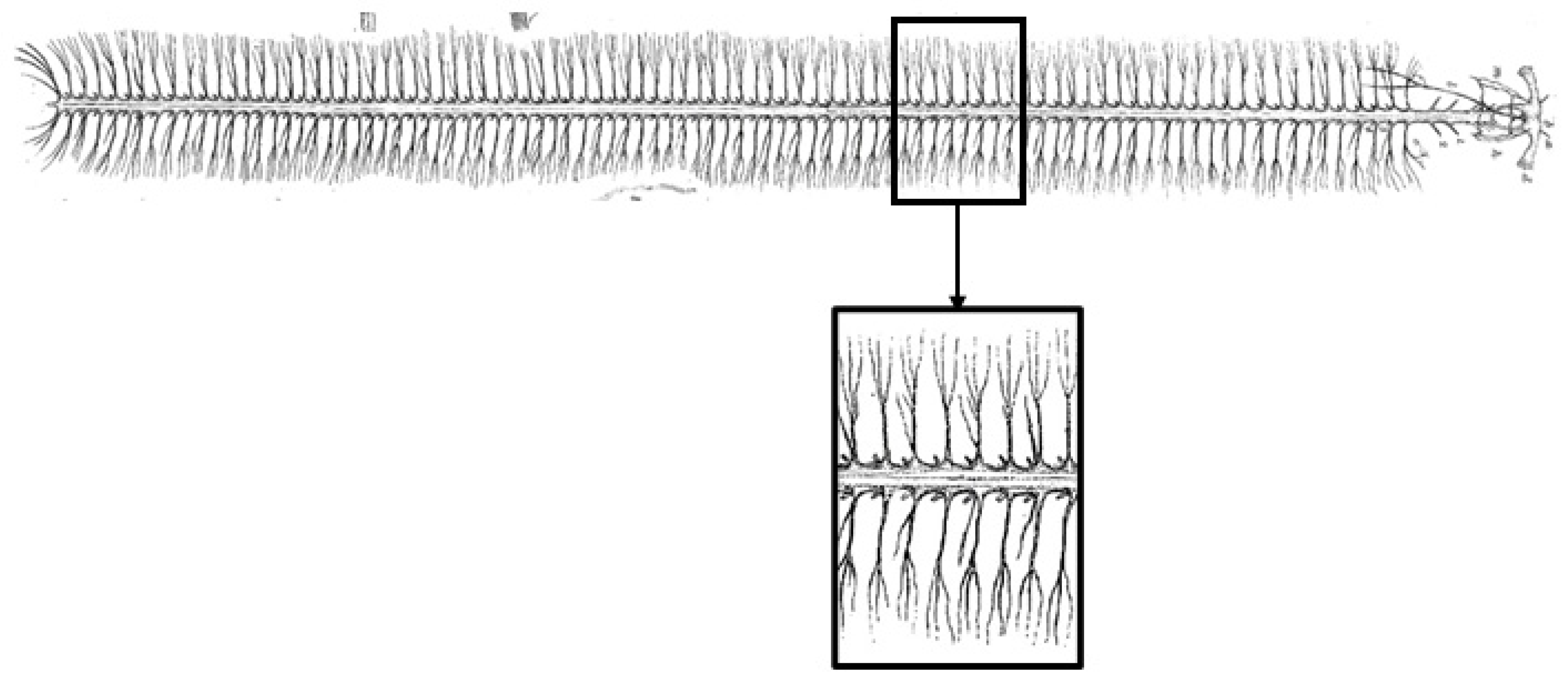


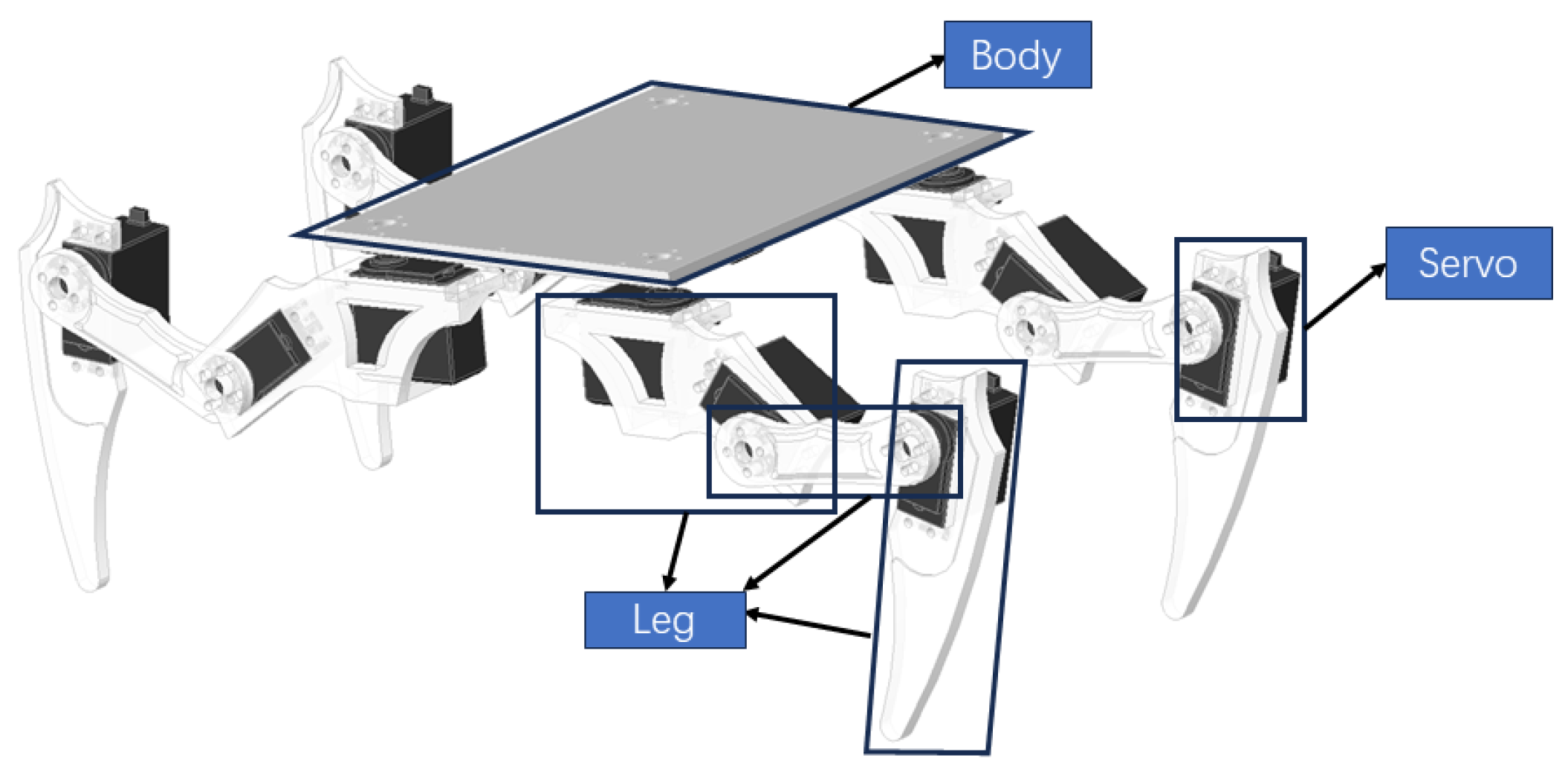
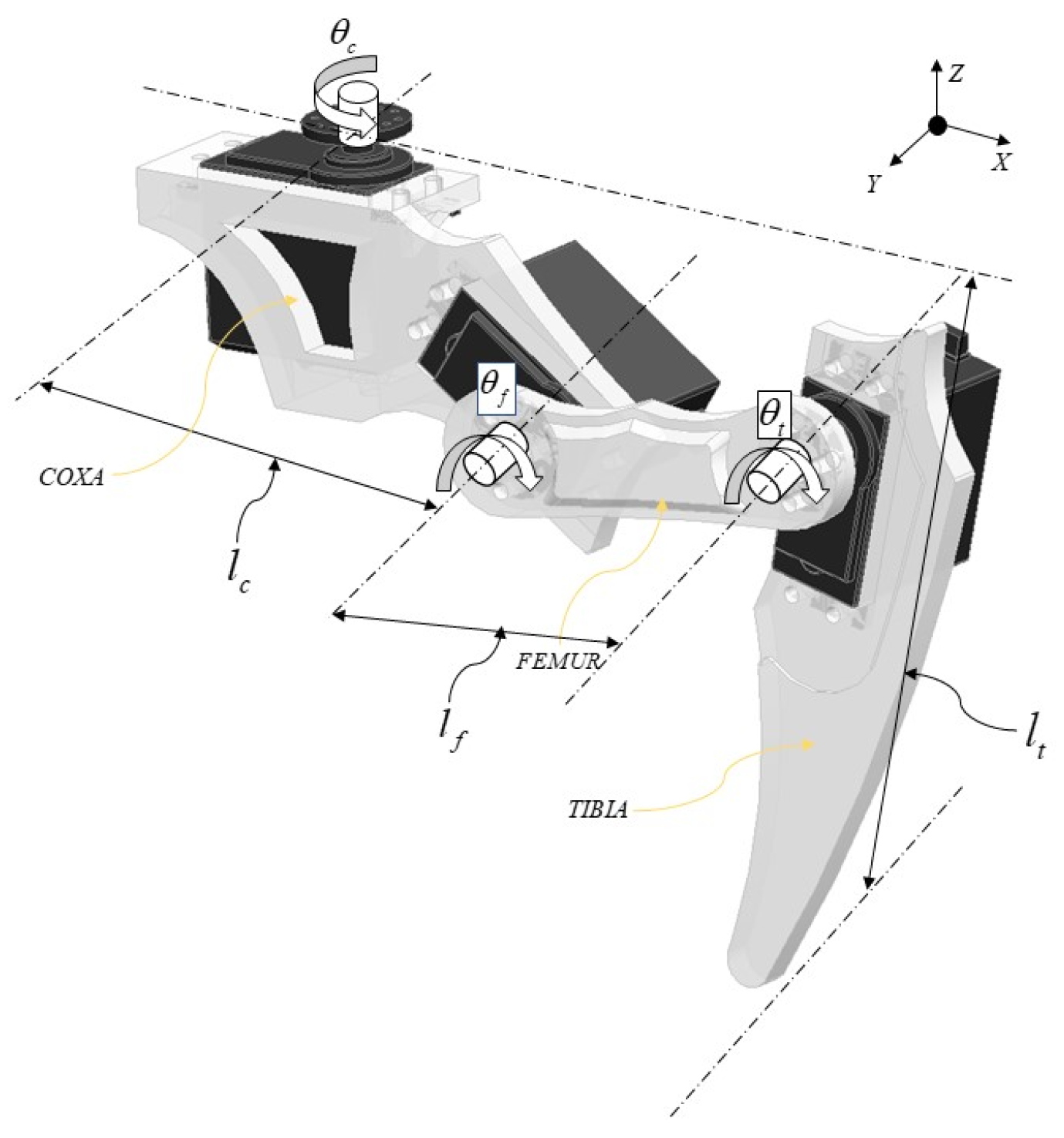
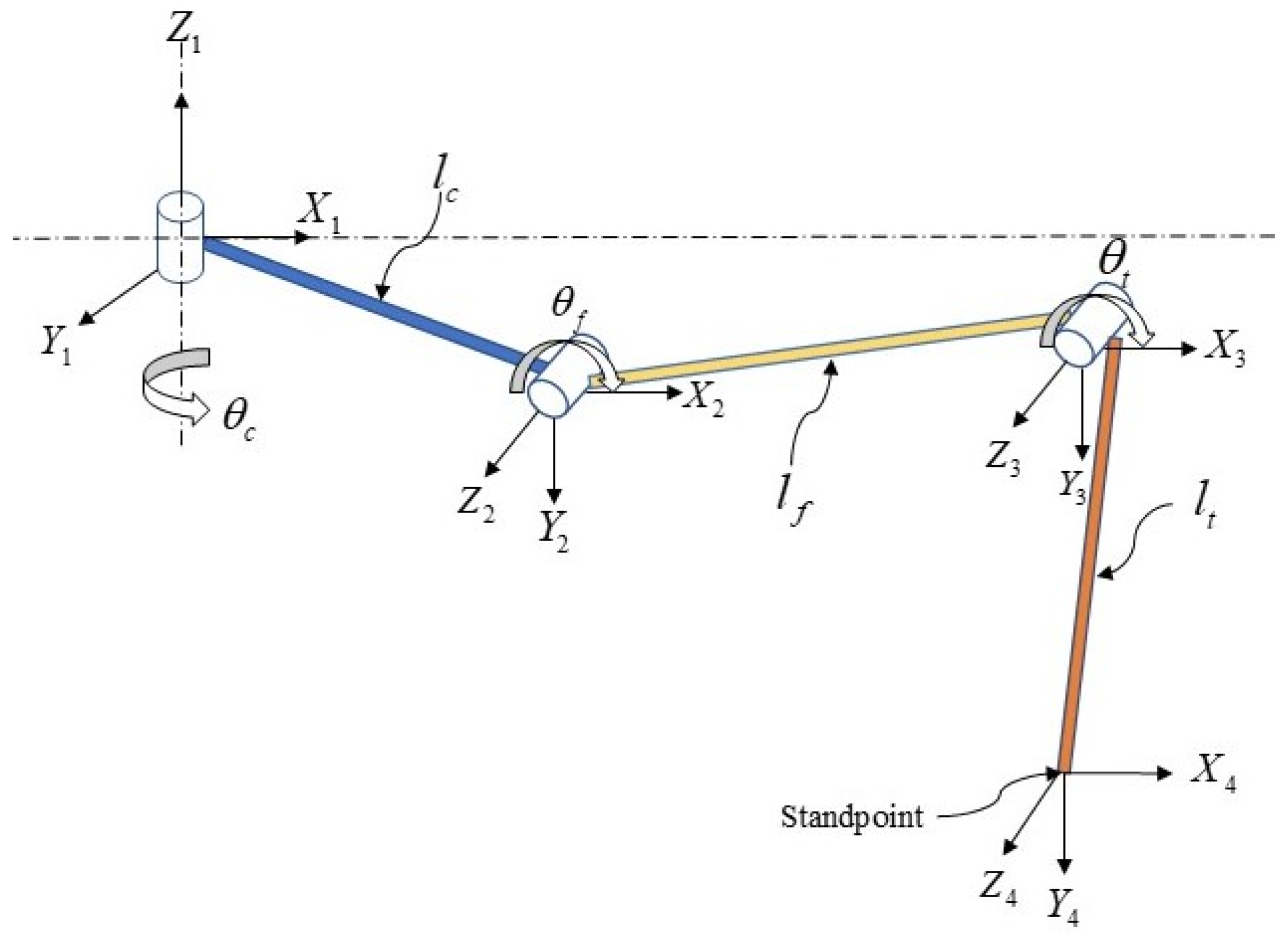
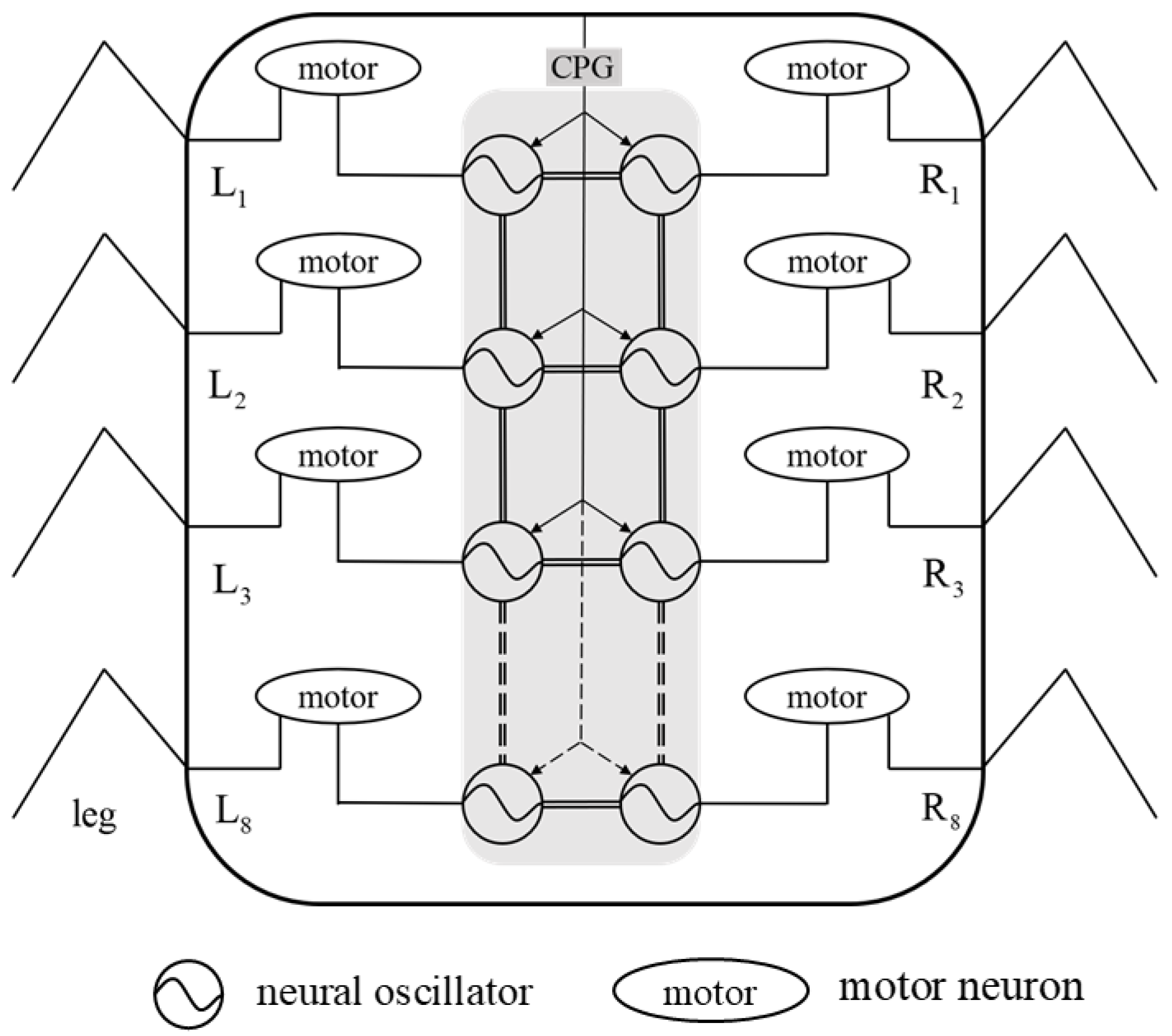
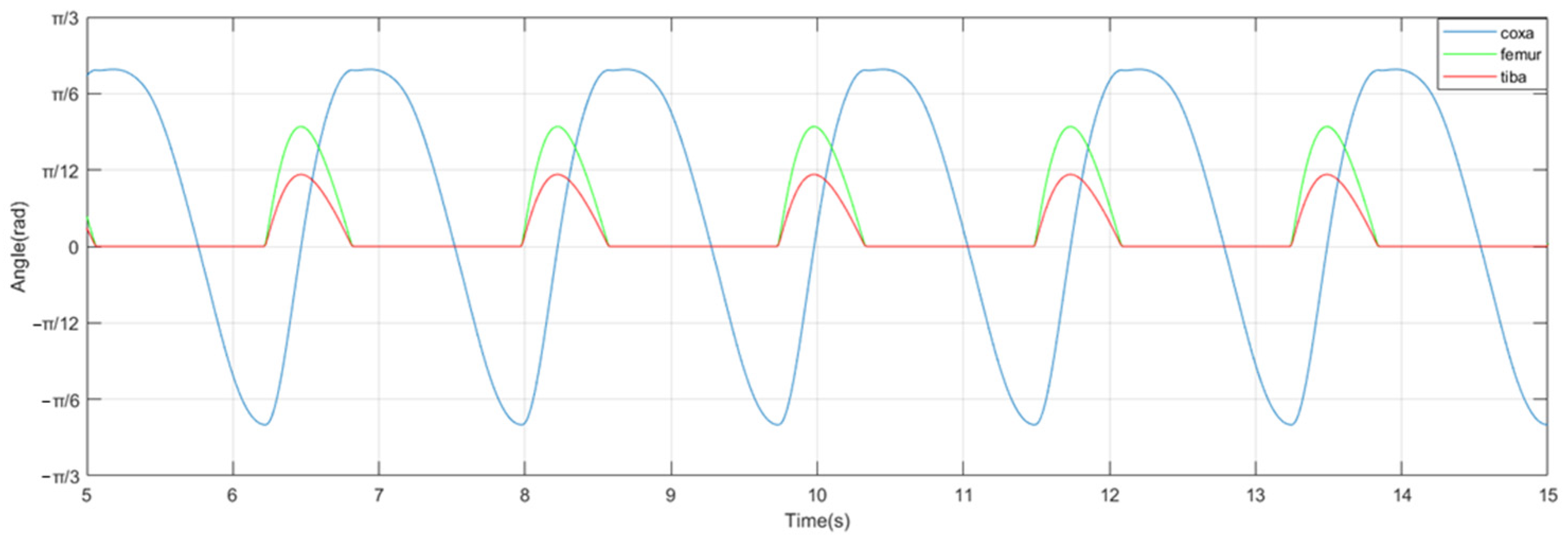




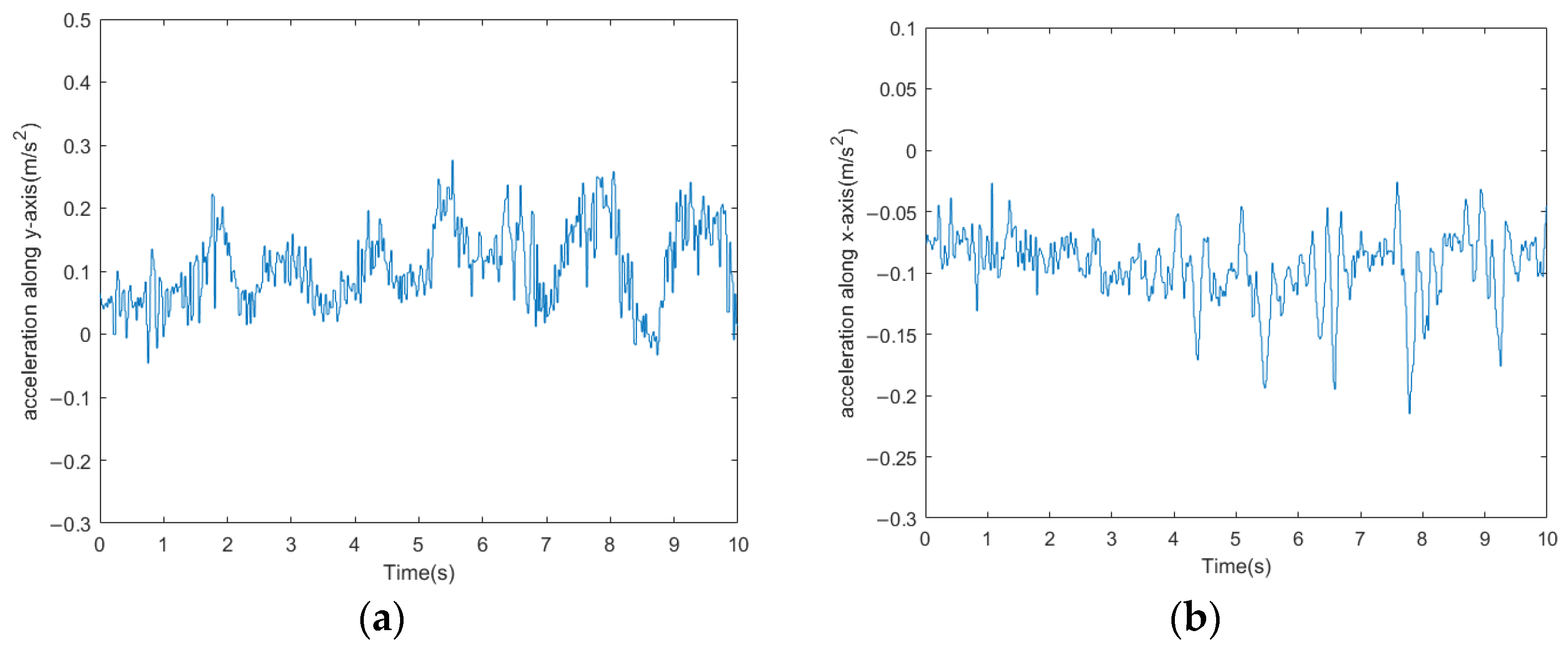
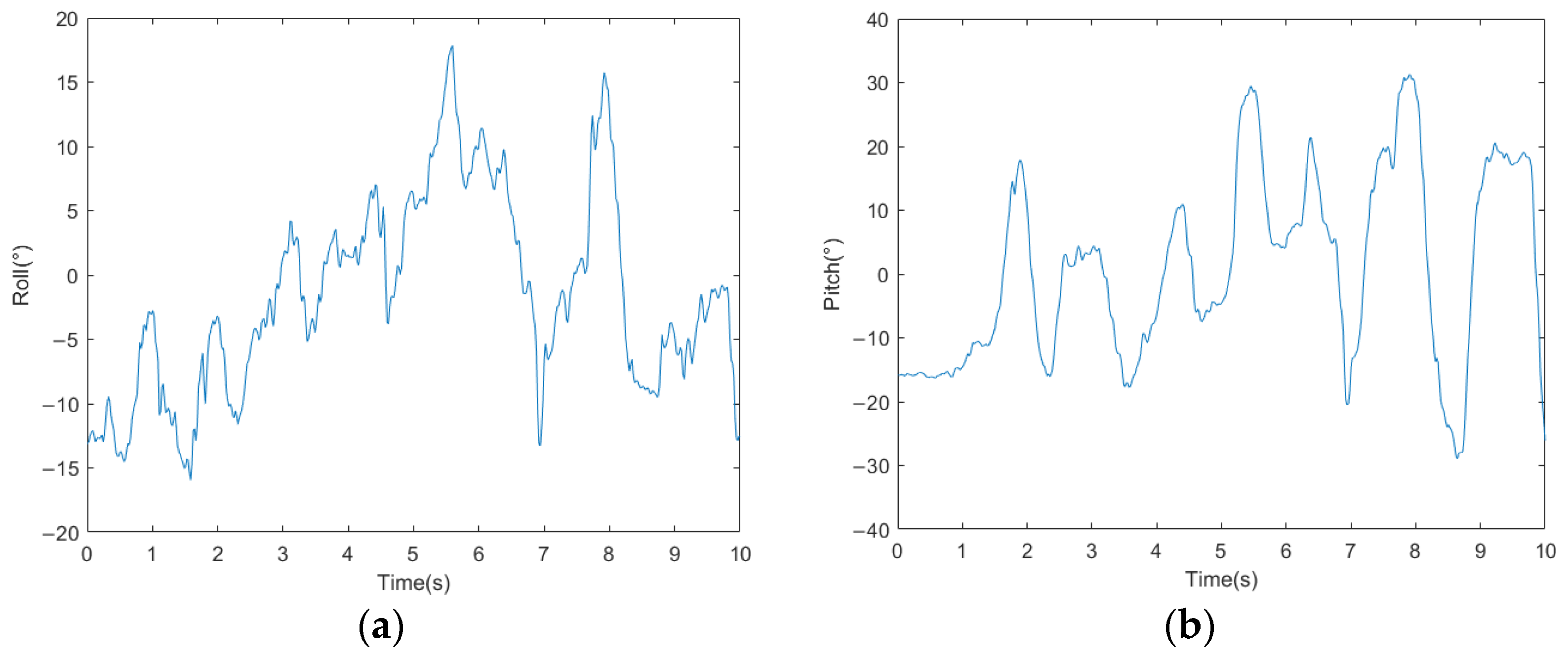
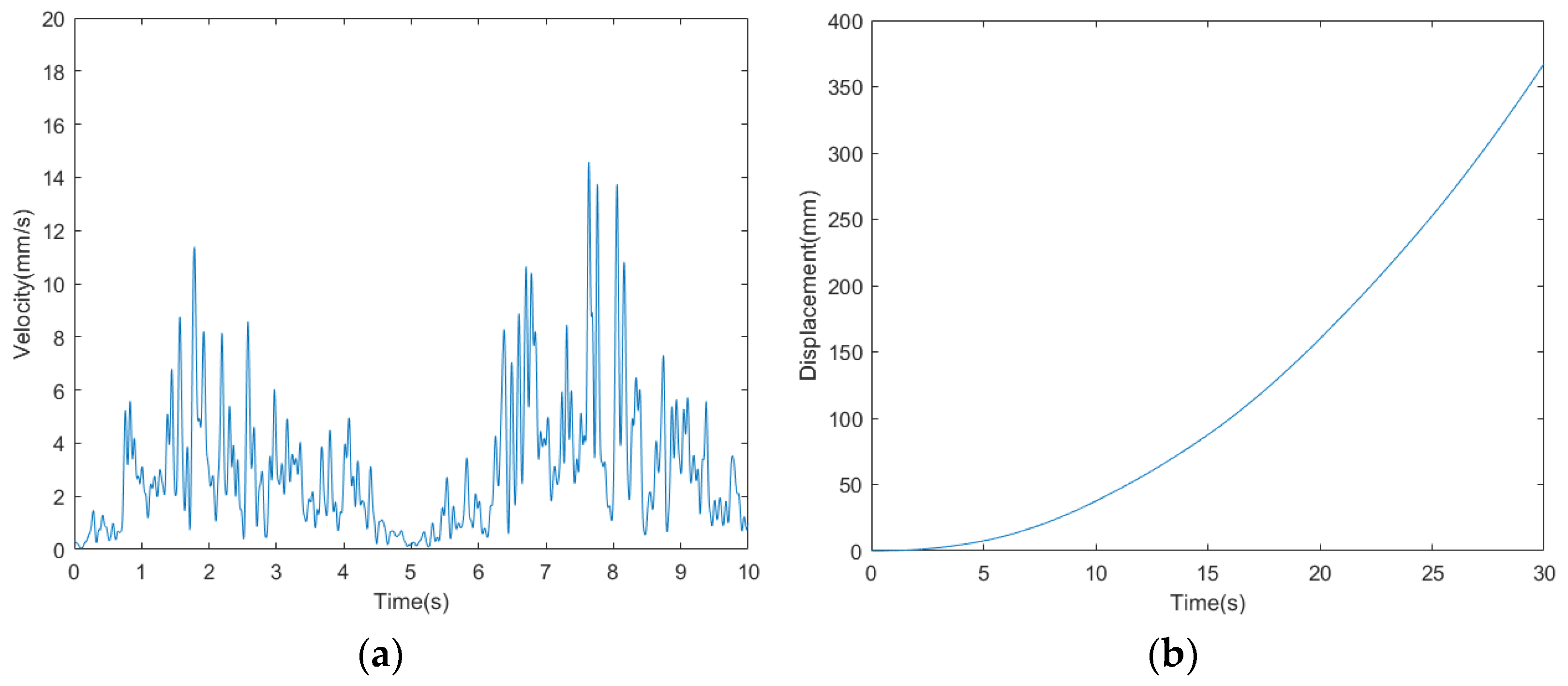





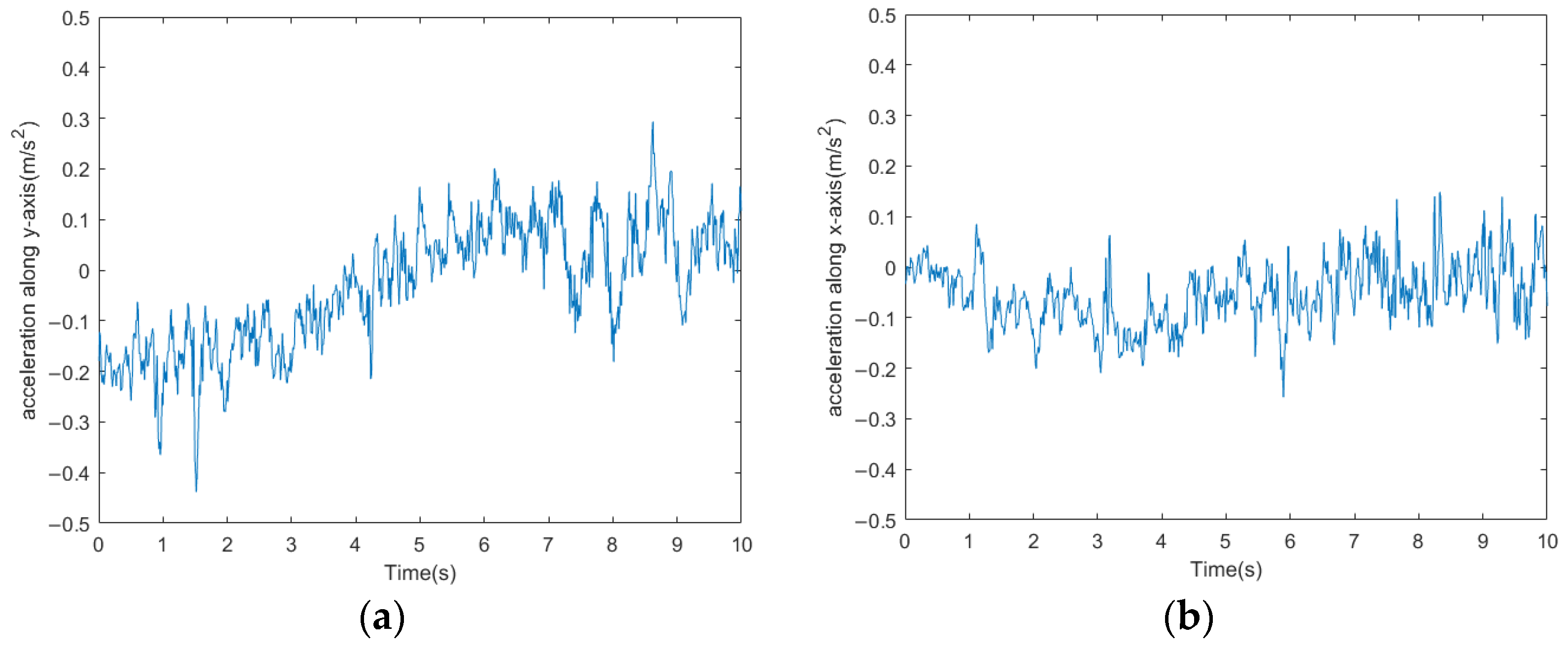
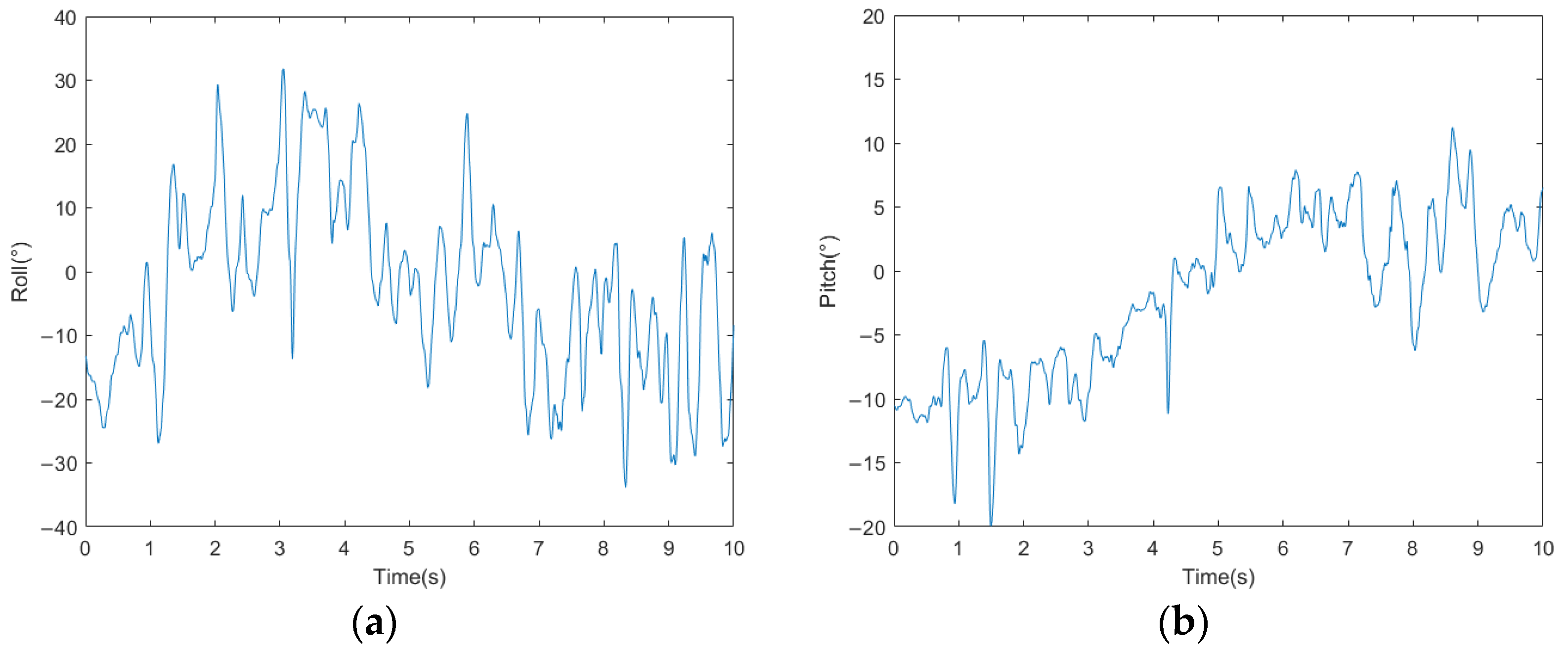
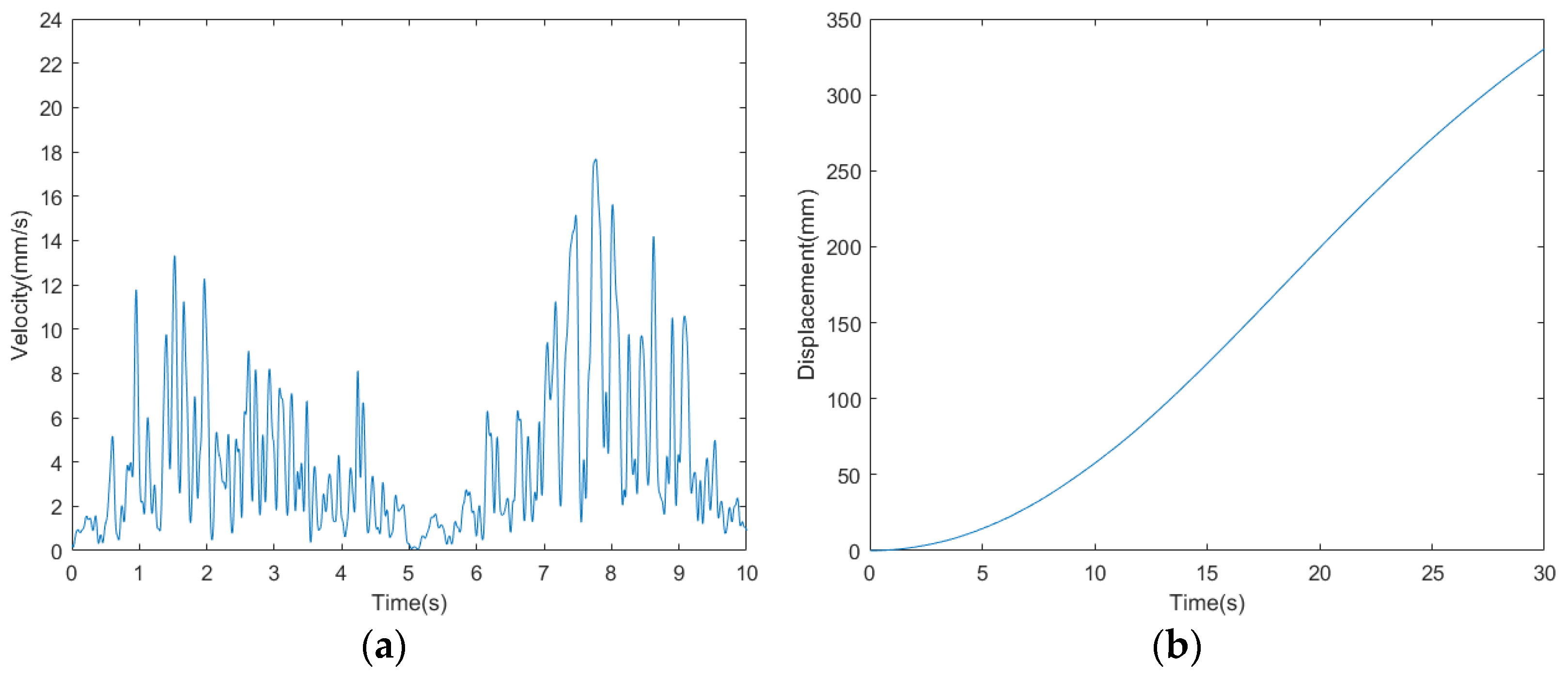
| i | αi−1 | ai−1 | di | θi |
|---|---|---|---|---|
| 1 | 0 | 0 | 0 | θc |
| 2 | 90 | lc | 0 | θf |
| 3 | 0 | lf | 0 | θt |
| 4 | 0 | lt | 0 | 0 |
| Parameters | Numerical Value |
|---|---|
| size of body segments | 190 mm × 150 mm × 6 mm |
| length of first connecting rod | 110 mm |
| length of second connecting rod | 95 mm |
| length of third connecting rod | 130 mm |
| hip angle | −30–30° |
| femur and tibia angle | −45–45° |
| spring length | 120 mm |
| spring stiffness | 1.3 N/mm |
| weight | 8 kg |
Disclaimer/Publisher’s Note: The statements, opinions and data contained in all publications are solely those of the individual author(s) and contributor(s) and not of MDPI and/or the editor(s). MDPI and/or the editor(s) disclaim responsibility for any injury to people or property resulting from any ideas, methods, instructions or products referred to in the content. |
© 2024 by the authors. Licensee MDPI, Basel, Switzerland. This article is an open access article distributed under the terms and conditions of the Creative Commons Attribution (CC BY) license (https://creativecommons.org/licenses/by/4.0/).
Share and Cite
Yin, H.; Shi, R.; Liu, J. Structural Design and Control Research of Multi-Segmented Biomimetic Millipede Robot. Biomimetics 2024, 9, 288. https://doi.org/10.3390/biomimetics9050288
Yin H, Shi R, Liu J. Structural Design and Control Research of Multi-Segmented Biomimetic Millipede Robot. Biomimetics. 2024; 9(5):288. https://doi.org/10.3390/biomimetics9050288
Chicago/Turabian StyleYin, Hao, Ruiqi Shi, and Jiang Liu. 2024. "Structural Design and Control Research of Multi-Segmented Biomimetic Millipede Robot" Biomimetics 9, no. 5: 288. https://doi.org/10.3390/biomimetics9050288




